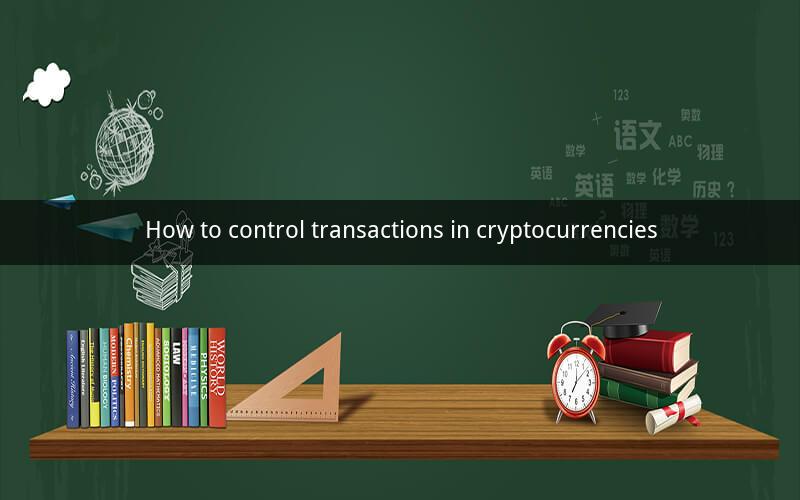
Table of Contents
1. Understanding Cryptocurrency Transactions
2. Importance of Transaction Control
3. Secure Wallets and Exchanges
4. Implementing Two-Factor Authentication
5. Utilizing Multi-Sig Wallets
6. Monitoring Transaction Activity
7. Keeping Private Keys Secure
8. Utilizing Cold Storage
9. Educating Yourself on Security Measures
10. Conclusion
1. Understanding Cryptocurrency Transactions
Cryptocurrency transactions are the backbone of blockchain technology. They allow users to send, receive, and trade digital assets securely and transparently. Transactions are recorded on a decentralized ledger, known as a blockchain, and are immutable, ensuring trust and security.
2. Importance of Transaction Control
Controlling transactions in cryptocurrencies is crucial for protecting your assets and maintaining financial security. Without proper control, you risk losing your funds to fraud, theft, or technical errors. Here’s why transaction control is essential:
- Preventing Unauthorized Access: By controlling transactions, you ensure that only authorized individuals can access and manage your digital assets.
- Reducing Risk of Fraud: With transaction control, you can monitor your wallet activity and identify suspicious transactions promptly.
- Enhancing Security: Implementing security measures like two-factor authentication and multi-sig wallets adds an extra layer of protection to your transactions.
3. Secure Wallets and Exchanges
Choosing a secure wallet and exchange is the first step in controlling your cryptocurrency transactions. Here are some key considerations:
- Hot Wallets: These wallets are connected to the internet and allow for quick transactions. However, they are more vulnerable to hacking and phishing attacks. Examples include mobile wallets and web wallets.
- Cold Wallets: These wallets are offline and offer the highest level of security. They are ideal for storing large amounts of cryptocurrencies. Examples include hardware wallets and paper wallets.
4. Implementing Two-Factor Authentication
Two-factor authentication (2FA) adds an extra layer of security to your wallet and exchange accounts. It requires you to provide two forms of verification before accessing your account, such as a password and a unique code sent to your phone.
- Password: Choose a strong, unique password that combines uppercase and lowercase letters, numbers, and symbols.
- Authentication Code: Enable 2FA on your wallet or exchange and ensure that you have access to the required authentication app or SMS service.
5. Utilizing Multi-Sig Wallets
Multi-signature (multi-sig) wallets require multiple private keys to authorize a transaction. This adds an extra layer of security, as an attacker would need to compromise multiple keys to steal your funds.
- Key Management: Keep your private keys secure and distribute them among trusted individuals or devices.
- Backup: Create backups of your private keys and store them in a safe location.
6. Monitoring Transaction Activity
Regularly monitoring your transaction activity can help you identify and respond to suspicious activity promptly. Here are some tips:
- Use Blockchain Explorer: Blockchain explorers allow you to view your transaction history and verify the authenticity of transactions.
- Set Up Alerts: Enable transaction alerts on your wallet or exchange to notify you of any unusual activity.
7. Keeping Private Keys Secure
Private keys are the digital keys that control access to your cryptocurrency. Keeping them secure is essential:
- Backup: Create backups of your private keys and store them in a safe location, such as a hardware wallet or encrypted file.
- Avoid Sharing: Never share your private keys with anyone, as they can be used to steal your funds.
8. Utilizing Cold Storage
Cold storage is a method of storing cryptocurrencies offline, reducing the risk of hacking and theft. Here’s how to use cold storage:
- Hardware Wallets: Store your private keys in a hardware wallet, which is a physical device designed for storing cryptocurrencies.
- Paper Wallets: Generate a paper wallet and write down your private keys and public address on a piece of paper.
9. Educating Yourself on Security Measures
Stay informed about the latest security measures and best practices in cryptocurrency. Here are some resources:
- Online Forums: Join cryptocurrency forums and communities to learn from experienced users.
- Security Blogs: Read security blogs and articles to stay up-to-date on the latest threats and solutions.
10. Conclusion
Controlling transactions in cryptocurrencies is essential for protecting your assets and maintaining financial security. By following the tips outlined in this article, you can reduce the risk of fraud, theft, and technical errors. Remember to stay informed and vigilant, as the cryptocurrency landscape is constantly evolving.
Questions and Answers
1. Q: What is a cryptocurrency transaction?
A: A cryptocurrency transaction is the process of sending, receiving, or trading digital assets on a blockchain network.
2. Q: Why is transaction control important?
A: Transaction control is crucial for preventing unauthorized access, reducing the risk of fraud, and enhancing security.
3. Q: What are hot wallets and cold wallets?
A: Hot wallets are connected to the internet and allow for quick transactions, while cold wallets are offline and offer the highest level of security.
4. Q: How can I implement two-factor authentication?
A: Enable 2FA on your wallet or exchange and use an authentication app or SMS service to receive a unique code.
5. Q: What is a multi-signature wallet?
A: A multi-signature wallet requires multiple private keys to authorize a transaction, adding an extra layer of security.
6. Q: How can I monitor my transaction activity?
A: Use a blockchain explorer and set up transaction alerts on your wallet or exchange.
7. Q: How can I keep my private keys secure?
A: Create backups of your private keys, avoid sharing them, and store them in a safe location.
8. Q: What is cold storage?
A: Cold storage is a method of storing cryptocurrencies offline, reducing the risk of hacking and theft.
9. Q: How can I stay informed about security measures?
A: Join cryptocurrency forums, read security blogs, and stay up-to-date on the latest threats and solutions.
10. Q: What are some common security threats in cryptocurrencies?
A: Common security threats include phishing attacks, hacking, malware, and technical errors.